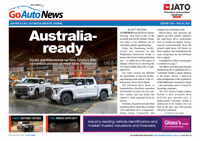 1 Nov 2006
1 Nov 2006
AFTER a seven-year hiatus, Mitsubishi relaunched its two-door short-wheelbase Pajero alongside a significantly revised four-door, seven-seater wagon, as part of the 2007 NS line-up.
The two-door Pajero is available in turbo-diesel and petrol R and X versions, while the wagon continues in the rural-focused GLX (it has rear differential locks), sporty mid-range VRX and top-of-the-range Exceed.
Being derived from the monocoque-bodied NM to NP-generation model, the NS has impeccable off-road credentials with a dedicated low-range in all its vehicles.
A three-door Ralliart version will also be offered but Mitsubishi has said this will only get body kit and visual highlights. There will be no engine modifications.
Mitsubishi says that 75 per cent of the NS’ exterior is new. Only the roof and door apertures remain the same.
The front end is redesigned. The mudguards lose their pronounced "blisters" and combined with the new flatter aluminium bonnet, the SUV gains a squarer look.
The spare is now mounted lower and in the centre of the rear door, offering better reward visibility, and all the rear light clusters now operate in their normal positions.
Inside the NS Pajero scores a fresh dashboard, improved quality and trim materials as well as better sound insulation.
In the five-door, the car’s third-row rear seats fold flat into the luggage floor.
The NS uses the same suspension, with minor revisions, so it remains a double wishbone, coil spring set-up up front, and a multi-link coil spring arrangement behind.
The car sits on the same 2780mm wheelbase as the previous model but is 70mm longer, 15mm higher and 10mm narrower. The front and rear tracks have been increased 10mm to 1570mm.
Wading depth has gone up from 600mm to 700mm while the ground clearance remains 225mm.
As part of its Mitsubishi All Terrain Technology (MATT), all models gain standard ASC active stability control, traction control, engine brake assist control, super select II AWD, multi-mode anti-locking brakes and hill-hold assist on automatic models.
This Pajero’s petrol and diesel engines are more powerful and offer more torque. They are also more economical and Euro 4 compatible.
The 3.8-litre 24-valve V6 MIVEC petrol engine delivers 184kW at 6000rpm and 329Nm at 2750rpm, while a new common rail diesel, replaces the previous 3.2-litre direct injection diesel (Di-D).
Also of 3.2-litre capacity, the CDi inter-cooled turbo-diesel pumps out 125kW ad 3800rpm and 358Nm from 2000rpm.
Both engines can be mated to either a five-speed manual or Mitsubishi’s five-speed INVECS II "smart logic" automatic with a sports mode sequential shift function.
Drive is put to the ground through Mitsubishi’s "super select II" drive train that incorporates all the features of MATT.
The Pajero’s four-wheel drive system can be engaged or disengaged on the move at speeds up to 100km/h and has the full range of serious off-road modes with a locked transfer.
Mitsubishi did extensive testing in Australia for the ABS and ASC tuning, dust sealing and hot weather conditions.

























